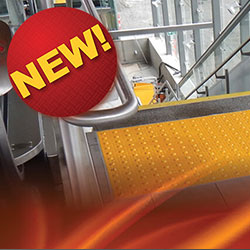









If you're on the hunt for an affordable and totally legit solution to spruce up those tactile warning surfaces in your fancy interior projects, then you got to check out the Access Tile® Surface Applied Fire Resistant Tactile. Trust us; this thing is a game-changer! It's the only fire-resistant tactile tile in town that meets all the requirements of the Ontario Building Code and other Canadian codes. In this nifty guide, we're going to break it down for you—what it is, how it works, and why it's the bee's knees for your next big project. So, buckle up, and let's dive right in!
Access Tile® Surface Applied Fire Resistant Tactile is a product that provides tactile walking surface indicators (TWSI) with truncated domes for interior applications in high-rise buildings and is mandatory in buildings higher than 7 floors. TWSI is designed to alert people with visual impairments of potential hazards or changes in direction on the floor surface. Truncated domes are raised bumps that can be felt through footwear or detected by a cane.
Access Tile® Surface Applied Fire Resistant Tactile is made of a proprietary composite material called FIRESENTRY-X™, which has a low flame spread and smoke development rating. This means that the product can withstand high temperatures and prevent fire from spreading in case of an emergency. The product also has high slip resistance, durability, and strength, making it suitable for various environments and traffic conditions.
Access Tile® FR is fully compliant with all Canadian Accessibility Codes and meets the standards set by the Ontario Building Code (OBC) 2012 Table 3.1.13.7, ensuring that your premises are easily accessible to everyone.
Access Tile® Surface Applied Fire Resistant Tactile can be easily installed on any existing concrete surface using adhesive, anchors, and stainless-steel pins. The product comes in six different sizes and three standard colors (federal yellow, dark grey, and onyx black) and can be cut to fit any shape or radius. The product also features beveled edges that make a smooth transition between the tile and the floor surface.
The product works by providing a contrast in texture, color, and sound between the tile and the surrounding floor surface. This contrast helps people with visual impairments identify the tile's location and direction and the hazard it indicates. For example, the tile can be used to mark the edge of a stairwell, a vestibule to an exit stair or lobby, or a corridor. The tile also helps people without visual impairments to notice the hazard and avoid accidents.
There are many reasons to choose Access Tile® Surface Applied Fire Resistant Tactile for your interior projects, such as:
Tiles can be cut to custom sizes or to make a radius using a continuous-rim diamond blade in a circular saw or mini-grinder. The use of a straightedge to guide the cut is advisable where appropriate.
If you are interested in learning more about Access Tile® Surface Applied Fire Resistant Tactile, please visit our solutions section or contact us today. We are happy to answer any questions you may have and help you find the best tactile solution for your project.
